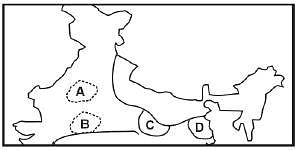UPSC Exam > UPSC Questions > The following map shows four of the sixteen m...
Start Learning for Free
The following map shows four of the sixteen mahajanapadas that existed in ancient India:

The places marked A, B, C and D respectively are:

The places marked A, B, C and D respectively are:
- a)Matsya, Chedi, Kosala, Anga
- b)Surasena, Avanti, Vatsa, Magadha
- c)Matsya, Avanti, Vatsa, Anga
- d)Surasena, Chedi, Kosala, Magadha
Correct answer is option 'C'. Can you explain this answer?
| FREE This question is part of | Download PDF Attempt this Test |
Most Upvoted Answer
The following map shows four of the sixteen mahajanapadas that existed...
Options A, B, C, D show Matsya, Avanti, Vatsa and AngaMahajanapada respectively. Matsya Mahajanapada was located in Jaipur region of Rajasthan. Viratnagar was its capital. Avanti Mahajanapada was located in the west and central region of Malwa. It had two parts- Northern Avanti (capital-Ujjayini) and Southern Avanti (capital-Mahishmati). Modern Allahabad and Banda districts constituted Vatsa Mahajanapada in ancient times. Its capital was Kaushambi. Modem Bhagalpur and Munger districts of Bihar were under the Anga Mahajanapada. Its capital was Champa.
Attention UPSC Students!
To make sure you are not studying endlessly, EduRev has designed UPSC study material, with Structured Courses, Videos, & Test Series. Plus get personalized analysis, doubt solving and improvement plans to achieve a great score in UPSC.

|
Explore Courses for UPSC exam
|

|
Similar UPSC Doubts
The following map shows four of the sixteen mahajanapadas that existed in ancient India:The places marked A, B, C and D respectively are:a)Matsya, Chedi, Kosala, Angab)Surasena, Avanti, Vatsa, Magadhac)Matsya, Avanti, Vatsa, Angad)Surasena, Chedi, Kosala, MagadhaCorrect answer is option 'C'. Can you explain this answer?
Question Description
The following map shows four of the sixteen mahajanapadas that existed in ancient India:The places marked A, B, C and D respectively are:a)Matsya, Chedi, Kosala, Angab)Surasena, Avanti, Vatsa, Magadhac)Matsya, Avanti, Vatsa, Angad)Surasena, Chedi, Kosala, MagadhaCorrect answer is option 'C'. Can you explain this answer? for UPSC 2024 is part of UPSC preparation. The Question and answers have been prepared according to the UPSC exam syllabus. Information about The following map shows four of the sixteen mahajanapadas that existed in ancient India:The places marked A, B, C and D respectively are:a)Matsya, Chedi, Kosala, Angab)Surasena, Avanti, Vatsa, Magadhac)Matsya, Avanti, Vatsa, Angad)Surasena, Chedi, Kosala, MagadhaCorrect answer is option 'C'. Can you explain this answer? covers all topics & solutions for UPSC 2024 Exam. Find important definitions, questions, meanings, examples, exercises and tests below for The following map shows four of the sixteen mahajanapadas that existed in ancient India:The places marked A, B, C and D respectively are:a)Matsya, Chedi, Kosala, Angab)Surasena, Avanti, Vatsa, Magadhac)Matsya, Avanti, Vatsa, Angad)Surasena, Chedi, Kosala, MagadhaCorrect answer is option 'C'. Can you explain this answer?.
The following map shows four of the sixteen mahajanapadas that existed in ancient India:The places marked A, B, C and D respectively are:a)Matsya, Chedi, Kosala, Angab)Surasena, Avanti, Vatsa, Magadhac)Matsya, Avanti, Vatsa, Angad)Surasena, Chedi, Kosala, MagadhaCorrect answer is option 'C'. Can you explain this answer? for UPSC 2024 is part of UPSC preparation. The Question and answers have been prepared according to the UPSC exam syllabus. Information about The following map shows four of the sixteen mahajanapadas that existed in ancient India:The places marked A, B, C and D respectively are:a)Matsya, Chedi, Kosala, Angab)Surasena, Avanti, Vatsa, Magadhac)Matsya, Avanti, Vatsa, Angad)Surasena, Chedi, Kosala, MagadhaCorrect answer is option 'C'. Can you explain this answer? covers all topics & solutions for UPSC 2024 Exam. Find important definitions, questions, meanings, examples, exercises and tests below for The following map shows four of the sixteen mahajanapadas that existed in ancient India:The places marked A, B, C and D respectively are:a)Matsya, Chedi, Kosala, Angab)Surasena, Avanti, Vatsa, Magadhac)Matsya, Avanti, Vatsa, Angad)Surasena, Chedi, Kosala, MagadhaCorrect answer is option 'C'. Can you explain this answer?.
Solutions for The following map shows four of the sixteen mahajanapadas that existed in ancient India:The places marked A, B, C and D respectively are:a)Matsya, Chedi, Kosala, Angab)Surasena, Avanti, Vatsa, Magadhac)Matsya, Avanti, Vatsa, Angad)Surasena, Chedi, Kosala, MagadhaCorrect answer is option 'C'. Can you explain this answer? in English & in Hindi are available as part of our courses for UPSC.
Download more important topics, notes, lectures and mock test series for UPSC Exam by signing up for free.
Here you can find the meaning of The following map shows four of the sixteen mahajanapadas that existed in ancient India:The places marked A, B, C and D respectively are:a)Matsya, Chedi, Kosala, Angab)Surasena, Avanti, Vatsa, Magadhac)Matsya, Avanti, Vatsa, Angad)Surasena, Chedi, Kosala, MagadhaCorrect answer is option 'C'. Can you explain this answer? defined & explained in the simplest way possible. Besides giving the explanation of
The following map shows four of the sixteen mahajanapadas that existed in ancient India:The places marked A, B, C and D respectively are:a)Matsya, Chedi, Kosala, Angab)Surasena, Avanti, Vatsa, Magadhac)Matsya, Avanti, Vatsa, Angad)Surasena, Chedi, Kosala, MagadhaCorrect answer is option 'C'. Can you explain this answer?, a detailed solution for The following map shows four of the sixteen mahajanapadas that existed in ancient India:The places marked A, B, C and D respectively are:a)Matsya, Chedi, Kosala, Angab)Surasena, Avanti, Vatsa, Magadhac)Matsya, Avanti, Vatsa, Angad)Surasena, Chedi, Kosala, MagadhaCorrect answer is option 'C'. Can you explain this answer? has been provided alongside types of The following map shows four of the sixteen mahajanapadas that existed in ancient India:The places marked A, B, C and D respectively are:a)Matsya, Chedi, Kosala, Angab)Surasena, Avanti, Vatsa, Magadhac)Matsya, Avanti, Vatsa, Angad)Surasena, Chedi, Kosala, MagadhaCorrect answer is option 'C'. Can you explain this answer? theory, EduRev gives you an
ample number of questions to practice The following map shows four of the sixteen mahajanapadas that existed in ancient India:The places marked A, B, C and D respectively are:a)Matsya, Chedi, Kosala, Angab)Surasena, Avanti, Vatsa, Magadhac)Matsya, Avanti, Vatsa, Angad)Surasena, Chedi, Kosala, MagadhaCorrect answer is option 'C'. Can you explain this answer? tests, examples and also practice UPSC tests.

|
Explore Courses for UPSC exam
|

|
Signup for Free!
Signup to see your scores go up within 7 days! Learn & Practice with 1000+ FREE Notes, Videos & Tests.
























